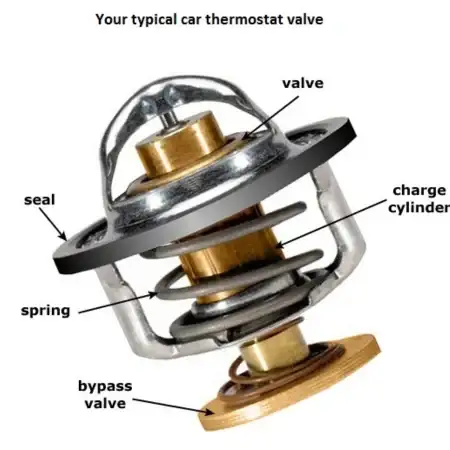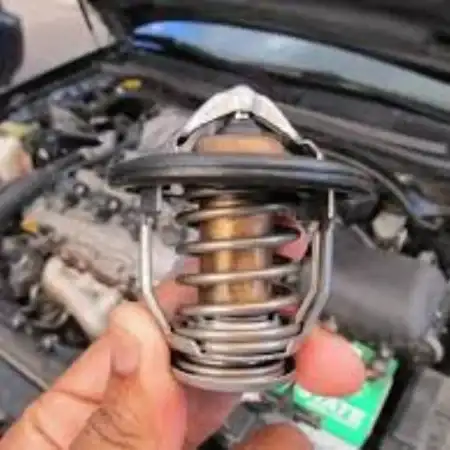A thermostat in a car is like a temperature regulator. It is a tiny smart device that helps keep the car’s engine at the right temperature. Just like you’d adjust the heat in your house to stay comfortable, the thermostat makes sure the engine doesn’t get too hot or too cold. It does this by controlling the flow of coolant, a liquid that helps keep the engine at just the right temperature for it to work well. So, the thermostat is a small but important part that plays a big role in keeping your car’s engine happy and running smoothly. But you are to find out the potential benefits of removing thermostat in a car. In this article I will discuss all about thermostats in a car, So keep on reading.
Is it ok to remove the thermostat?
Removing the thermostat from a car is generally not recommended, as it can cause more harm than good. The thermostat plays a crucial role in regulating the engine’s temperature. Here are some reasons why it’s important to keep the thermostat:
Engine Efficiency:
The engine operates optimally within a specific temperature range. The thermostat regulates the coolant flow to maintain this temperature. If you remove the thermostat, the engine may struggle to stay within the recommended temperature range.
Overheating can occur without proper temperature regulation, leading to issues like reduced lubrication and increased friction in engine components. This can ultimately result in decreased efficiency and potential damage to the engine.
Fuel Efficiency:
The thermostat ensures that the engine reaches and maintains its ideal operating temperature. This is important for achieving the best fuel combustion efficiency.
Without the thermostat, the engine may operate at temperatures either too high or too low, causing inefficient combustion. Inefficient combustion typically leads to increased fuel consumption, as the engine struggles to convert fuel into energy effectively.
Emissions Control:
Modern vehicles are equipped with emission control systems designed to minimize the release of harmful pollutants into the environment.
The thermostat plays a role in the proper functioning of these systems. If the engine temperature is not regulated correctly, it can negatively impact the efficiency of emission control devices, resulting in higher levels of pollutants being released into the air.
Engine Wear:
Overheating is a significant contributor to engine wear and tear. When the engine operates at excessively high temperatures, it puts additional stress on various components.
Continuous overheating can lead to the breakdown of lubricants, accelerated wear of moving parts, and potential damage to critical engine components. Removing the thermostat increases the risk of overheating, which, in turn, can shorten the overall lifespan of the engine.

benefits of removing thermostat in a car ( pros and cons )
Pros (Possible Advantages)
Here are some benefits of removing the thermostat in a car.
1- Cold Climate Consideration:
In colder weather conditions, engines can take longer to reach their optimal operating temperature. Without a thermostat restricting coolant flow, the engine can warm up more quickly, allowing the vehicle to generate heat faster. This can be particularly useful in cold climates where a faster warm-up contributes to improved cabin heating and defrosting, enhancing overall comfort and visibility.
2- Quick Response for Short Drives:
In situations where you frequently take short drives and need your engine to warm up rapidly, the absence of a thermostat might be seen as an advantage. However, it’s important to note that modern engines are designed to operate efficiently within specific temperature ranges, and continuous short trips may not be ideal for the engine’s health regardless of thermostat presence.
3- Reduced Complexity:
Some individuals, especially DIY enthusiasts, might consider a simplified cooling system as an advantage. Without a thermostat regulating the flow of coolant, there’s one less component to worry about. This could be appealing to those who prefer simpler maintenance routines or want to modify their vehicles for specific purposes.
4- Customization for Specialized Applications:
In certain cases, individuals may remove the thermostat as part of modifications for specific uses, such as racing or off-road applications. These scenarios, however, require careful consideration of the engine’s specific requirements and potential trade-offs.

You can check the thermostat: Click here
Cons (Potential Disadvantages)
1- Coolant Regulation:
The thermostat acts as a gatekeeper for the engine’s coolant circulation. It opens and closes to regulate the flow of coolant, ensuring that the engine stays within the ideal temperature range. Without this regulation, there’s a heightened risk of the engine running too hot.
2- Consequences of Overheating:
Engine components are designed to operate within specific temperature limits. If the engine consistently operates at elevated temperatures due to the absence of a thermostat, it can lead to the breakdown of lubricants, increased friction, and potential damage to critical components. Overheating is a common precursor to engine failure.
3- Optimal Combustion Temperature:
The thermostat helps the engine reach and maintain the temperature at which fuel combustion is most efficient. Without this control, the engine may operate at temperatures that hinder efficient combustion.
4- Increased Fuel Consumption:
Inefficient combustion not only reduces fuel efficiency but also leads to increased fuel consumption. This is because the engine struggles to convert fuel into usable energy effectively, resulting in more fuel being burned for the same amount of work.
5- Emission Control Systems:
The thermostat is integral to the proper functioning of emission control systems in modern vehicles. These systems rely on the engine operating within specific temperature parameters for optimal performance.
6- Environmental Impact:
Removing the thermostat can disrupt the effectiveness of emission control devices, leading to higher levels of pollutants being released into the air. This not only contributes to environmental pollution but may also result in non-compliance with emission standards.
7- Impact of Overheating:
Overheating, a consequence of removing the thermostat, accelerates wear and tear on engine components. Continuous exposure to high temperatures can break down lubricants, cause increased friction, and lead to premature wear and damage.
8- Maintenance Costs:
The potential for increased wear and damage often translates to higher maintenance costs. Repairs and replacements of engine components can become more frequent and costly.
While removing the thermostat may seem like a simple modification, it can have profound and negative consequences on the engine’s performance, efficiency, emissions, and overall longevity. It’s crucial to weigh the potential advantages against these significant drawbacks and, if considering such a modification, consult with automotive professionals to make informed decisions about the vehicle’s well-being.
Must Read
- How To Clear Service Suspension System? Explained
- How To Start A Car With A Bad Crankshaft Sensor?
- What Happens If My Drive Shaft Breaks While Driving?
Conclusion
Benefits of removing the thermostat: Removing a car’s thermostat might promise quicker warm-ups and a simpler cooling system, but the potential downsides are significant. Engine overheating, reduced fuel efficiency, increased emissions, and accelerated wear and tear can outweigh any perceived benefits. The thermostat, a seemingly small component, plays a crucial role in maintaining engine health and efficiency. Before deciding to remove it, careful consideration and consultation with automotive professionals are essential to ensure a well-balanced and reliable vehicle performance.
